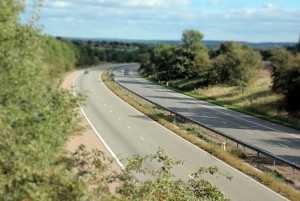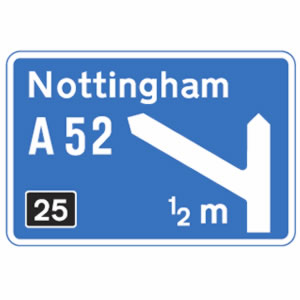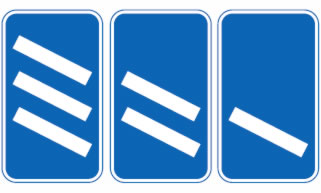Even though motorways cause a great deal of fear in those that have not experienced them or have little experience, they are in fact the safest roads to drive on in Britain.
Motorway lanes are often wide and straight, have no roundabouts or right turns. Still, many of us prefer to avoid motorways by taking the longer route. Detailed in this section is the correct procedure for joining UK motorways, driving on motorways along with the rules. Provided are tutorials complete with diagrams and motorway road signs for safe motorway driving.
Joining a motorway
This is the part that most people dread, especially when joining a busy motorway. Joining a motorway is essentially the same as joining a dual carriageway, which most of us have done. With practice, you will become more confident and find the process easier. The main process for joining a motorway is:
- to assess the traffic on the motorway as early as possible from the slip road and to adjust your speed to a similar speed that they are driving.
- signal to the right before joining to show your intention of joining. This especially allows other traffic to see you at night.
- give priority to traffic already on the motorway. Usually traffic will slow down or move to another lane if it appears difficult for you to access the carriageway.
- frequently look into your right mirror and over your right shoulder before joining to ensure it is safe.
- not to drive on the hard shoulder, but once joined, stay in the left lane until you have become accustomed with the speed and conditions.
For further information on joining a motorway, along with the correct procedure and motorway signs that you may encounter whilst joining, see:
Driving on a motorway
Motorways can range from 2 lanes upwards and use blue signs compared to dual carriageway A roads that use green signs. As soon as you have joined a motorway, remain in the left lane until you have become accustomed to the change of speed and the traffic around you.

Motorways are high speed of a maximum of 70 mph. Due to the high speed, situations can change very quickly. Looking well ahead for any potential changes in lanes or traffic is just as important as being aware of the traffic directly around you. Not everyone is permitted to use motorways. Learner riders of motorbikes or motorbikes of under 50cc engine size are not permitted to use motorways. Cyclists, horse riders and certain slow-moving vehicles or over sized vehicles without special permission are also not permitted to use motorways.
Learner drivers are now permitted to drive on motorways provided they are accompanied by an approved driving instructor (ADI) and that the training vehicle has dual controls fitted. However, the practical driving test does not involve driving on motorways and if a test candidate were to accidentally join a motorway and if it was the test candidates fault, a test failure would be issued.
Motorway reflective studs
The motorway reflective studs or cat’s eyes are used to help drivers establish the correct lane and lane discipline during low light conditions. Motorway studs use a specific colour depending on their placement on the carriageway.
Motorway signals
Motorway light signals are used to inform traffic of any approaching danger or hazard for example accidents or bad weather visibility. See motorway signals for more information.
Motorway overtaking
Many motorway accidents are caused due to a lack of sufficient observation when changing lanes or overtaking. For the safety of yourself and others, it’s important that the MSM (Mirror, Signal, Manoeuvre) routine is used and also to check the car blind spot. A guide on the correct procedure for motorway overtaking is available.
Vehicles joining the motorway
Frequent all-round observation, including looking well-ahead is important to check for traffic joining the motorway. If you see other vehicles joining ahead, be prepared to either slow down gradually, being careful to take into account any vehicles behind you, or move to another lane using the motorway overtaking procedure. Often where there is an exit slip road indicated by this motorway sign, a motorway entrance slip road follows shortly after.

Motorway interchange
A motorway interchange is where a motorway may divide or merge together. An interchange sign such as the one blow will often give you a 1 mile warning giving you plenty of time to choose your required lane.
Getting the correct lane as early as possible is important as it may become difficult if left too late. Certain lanes may also have solid white lines the closer you get to the interchange, making it illegal to cross over.

Motorway exit
Motorway exit signs provide information where the junction will take you, the road name and how far the exit junction is. The exit sign initially gives you a 1 mile warning, followed by half a mile. Countdown markers are then used starting with a 300 yard marker, then 200 and finally a 100 yard marker.
Use the MSM routine at the 300 yard marker to give other traffic plenty of warning of your intentions. On the exit deceleration slip road, pay particular attention to signs providing information on which lane you need for your destination.

First time on a motorway
It is not compulsory that learner drivers are taught on motorways at any stage of their training. Therefore, your first drive on a motorway may be on your own.
Dual carriageways are similar to many motorways. If you are concerned about driving on a motorway, take plenty of practice on a dual carriageway initially before taking to the motorway. Motorways can be rather scary for the first time, but once you are on, you will soon realise that they’re not so bad after all. And remember, motorways are statistically the safest roads to drive on in the UK.
Motorway safety
Although motorways are the safest roads to drive on in the UK, a few checks and procedures can make your journey safer.
-
Car maintenance
Before taking a journey, ensure that your tyres are legal and have the correct air pressure in them. Basic car maintenance information such as legal tyre tread depth, oil and engine coolant details can be found in the Show Me Tell Me driving test questions. A car that is regularly serviced will generally be more reliable, have a longer engine life and produce better fuel economy. See section How to service a car for further information on a basic self-service.
-
Planning a journey
If your journey involves taking motorways, there are no areas that you can pull-over to look at a map or alter a sat-nav. A well-planned journey will reduce or eliminate the need to check directions. It is an offence to stop on a motorway hard shoulder, if you need to program a sat-nav or look at a map, wait for the next services area or take the next available exit off the motorway to find somewhere to pull-over.
-
Motorway lane discipline
A significant cause of motorway accidents is due to lack of effective observation when changing lanes or overtaking. Always check the appropriate blind spot and use the correct procedure for overtaking. When overtaking slower vehicles, remain in the middle or outer lanes until it is safe to move back into the left lane. This is a safer practice than constantly changing lanes. Always move back to the left lane once overtaking is complete.
-
Motorway following distance
Driving too close to a vehicle in-front, especially at high speed significantly reduces your thinking distance if there is a need to slow down quickly. Thinking distance is how far a vehicle travels from when a driver first realises their vehicle must be slowed or stopped, to when they actually use the brakes. The thinking distance is increased if a driver is tired or they are not concentrating on the road. The 2 second rule is and easy and effective method for calculating the minimum safe following distance.
-
Weather conditions while driving
The 2 second rule applies to good and dry driving conditions. The following distance needs to be adjusted accordingly depending on the conditions. If the conditions are wet, the 2 seconds need to be doubled to 4 and if the conditions are icy it is recommended that a minimum gap of 10 seconds is used to allow for a safe stopping distance.
-
Motorway tiredness
Driving on motorways can make you feel tired, increasing the risk of an accident. If you are undertaking a long motorway journey, allow for sufficient break. For every 2 hours of driving, it is recommended that you take a 15 minute break. If you are feeling sleepy, do not stop on the hard shoulder as this is dangerous and illegal. Stop at a services where they are you are likely to purchase caffeinated coffee, or take the next available exit to find a suitable place to stop for a short nap.
Guides and tutorials related to motorway driving
- Motorway slip road
- Motorway overtaking
- Motorway rules
- Motorway road signs
- Motorway signals
- Motorway reflective studs
